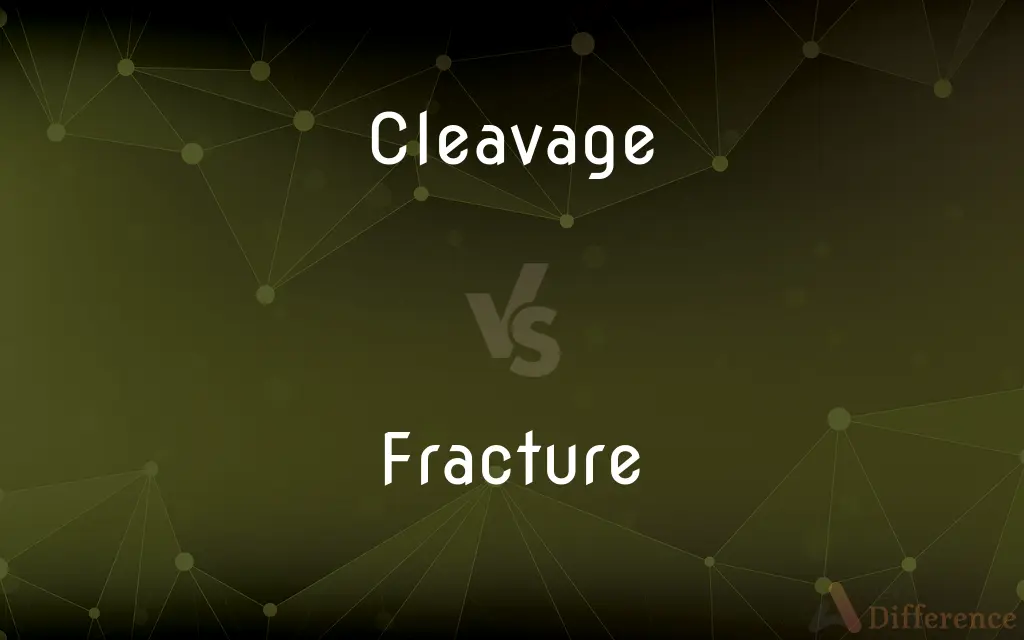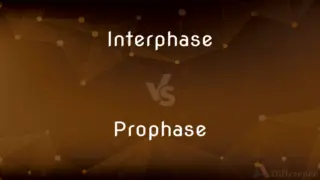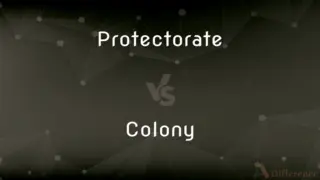Cleavage vs. Fracture — What's the Difference?
By Tayyaba Rehman & Urooj Arif — Updated on March 20, 2024
Cleavage refers to a mineral's tendency to break along flat, even surfaces, while fracture describes irregular breakage not aligned with cleavage planes.

Difference Between Cleavage and Fracture
Table of Contents
ADVERTISEMENT
Key Differences
Cleavage in minerals is characterized by the tendency to split along specific planes of weakness within the crystal structure, resulting in smooth, flat surfaces. This property is determined by the arrangement of atoms in the mineral and varies among different minerals. Fracture, on the other hand, occurs when a mineral breaks in a manner that does not align with its natural cleavage planes, leading to irregular, often rough surfaces.
The presence of cleavage is indicative of a mineral's internal structure and bonding, with different minerals exhibiting varying degrees of cleavage, from perfect to poor, based on the ease with which they split along these planes. Fractures can occur in any mineral but are the only means of breakage in minerals without cleavage, revealing more about the mineral's strength and tenacity than its structural arrangement.
Cleavage planes are predictable and consistent for a given mineral, providing a useful diagnostic tool in mineral identification. Fracture types, such as conchoidal (shell-like curves), uneven, or splintery, offer additional insights into a mineral's physical properties but are less uniform and predictable than cleavage.
Minerals with well-defined cleavage can be more easily split or shaped, which is particularly relevant in gem cutting and industrial applications. Fractured surfaces, while less controllable, can also influence how minerals are processed or used, especially in aggregate materials for construction.
Understanding cleavage and fracture is essential in geology and materials science, as these properties influence how rocks and minerals react to stress, weathering, and mechanical processing, impacting everything from landscape formation to the durability of building materials.
ADVERTISEMENT
Comparison Chart
Definition
Splitting along planes of weakness
Irregular breakage not on cleavage planes
Surface Appearance
Smooth, flat surfaces
Rough, uneven surfaces
Predictability
Consistent, predictable planes
Irregular, less predictable
Diagnostic Use
Indicator of mineral structure
Reveals mineral strength and tenacity
Application Impact
Influences gem cutting, shaping
Affects material processing, durability
Compare with Definitions
Cleavage
Minerals break along flat, even planes.
Mica exhibits perfect cleavage, splitting into thin sheets.
Fracture
Minerals break with uneven surfaces.
Quartz often breaks with a conchoidal fracture, resembling broken glass.
Cleavage
Reflects the atomic arrangement.
The cleavage of calcite demonstrates its rhombohedral crystal structure.
Fracture
Includes conchoidal, uneven, splintery.
Obsidian's conchoidal fracture contributes to its sharp edges.
Cleavage
Varies from perfect to poor.
Feldspar has two directions of good cleavage at nearly 90-degree angles.
Fracture
Provides insights into mineral properties.
The fracture pattern of pyrite can help in distinguishing it from gold.
Cleavage
Helps in mineral identification.
The cleavage properties of galena aid in distinguishing it from similar minerals.
Fracture
Reflects tenacity and cohesion.
The tough fracture of jasper indicates its strong internal bonds.
Cleavage
Facilitates shaping and cutting in the gem industry.
Cleavage is considered when cutting diamonds to maximize brilliance.
Fracture
Influences how materials are used.
The fracture characteristics of aggregate materials affect concrete strength.
Cleavage
The act of splitting or cleaving.
Fracture
Fracture is the separation of an object or material into two or more pieces under the action of stress. The fracture of a solid usually occurs due to the development of certain displacement discontinuity surfaces within the solid.
Cleavage
The state of being split or cleft; a fissure or division.
Fracture
The act or process of breaking.
Cleavage
(Mineralogy) The splitting or tendency to split of a crystallized substance along definite crystalline planes, yielding smooth surfaces.
Fracture
The condition of having been broken or ruptured
"a sudden and irreparable fracture of the established order" (W. Bruce Lincoln).
Cleavage
The series of mitotic cell divisions that produces a blastula from a fertilized ovum. It is the basis of the multicellularity of complex organisms. Also called segmentation.
Fracture
A break, rupture, or crack, especially in bone or cartilage.
Cleavage
Any single cell division in such a series.
Fracture
The characteristic manner in which a mineral breaks.
Cleavage
(Chemistry) The splitting of a complex molecule, such as a polysaccharide, into simpler molecules.
Fracture
The characteristic appearance of the surface of a broken mineral.
Cleavage
(Informal) The cleft between a woman's breasts as revealed by a low-cut garment.
Fracture
(Geology) A crack or fault in a rock.
Cleavage
The act of cleaving or the state of being cleft.
Fracture
To cause to break
The impact of the fall fractured the bone.
Cleavage
The hollow or separation between a woman's breasts, especially as revealed by a low neckline.
Fracture
To undergo a break in (a bone)
He fractured his ankle in the fall.
Cleavage
(by extension) Any similar separation between two body parts, such as the buttocks or toes.
Fracture
To disrupt or destroy as if by breaking
Fractured the delicate balance of power.
Cleavage
(biology) The repeated division of a cell into daughter cells after mitosis.
Fracture
To abuse or misuse flagrantly, as by violating rules
Ignorant writers who fracture the language.
Cleavage
(chemistry) The splitting of a large molecule into smaller ones.
Fracture
(Slang) To cause to laugh heartily
"Jack Benny fractured audiences ... for more than 50 years" (Newsweek).
Cleavage
(mineralogy) The tendency of a crystal to split along specific planes.
Fracture
To undergo a fracture.
Cleavage
(politics) The division of voters into voting blocs.
Fracture
An instance of breaking, a place where something has broken.
Cleavage
The act of cleaving or splitting.
Fracture
(medicine) A break in bone or cartilage.
Cleavage
The quality possessed by many crystallized substances of splitting readily in one or more definite directions, in which the cohesive attraction is a minimum, affording more or less smooth surfaces; the direction of the dividing plane; a fragment obtained by cleaving, as of a diamond. See Parting.
Fracture
(geology) A fault or crack in a rock.
Cleavage
Division into laminæ, like slate, with the lamination not necessarily parallel to the plane of deposition; - usually produced by pressure.
Fracture
(ambitransitive) To break, or cause something to break.
Cleavage
The state of being split or cleft
Fracture
To amuse (a person) greatly; to split someone's sides.
Cleavage
The breaking of a chemical bond in a molecule resulting in smaller molecules
Fracture
The act of breaking or snapping asunder; rupture; breach.
Cleavage
(embryology) the repeated division of a fertilised ovum
Fracture
The breaking of a bone.
Cleavage
The line formed by a groove between two parts (especially the separation between a woman's breasts)
Fracture
The texture of a freshly broken surface; as, a compact fracture; an even, hackly, or conchoidal fracture.
Cleavage
The act of cleaving or splitting
Fracture
To cause a fracture or fractures in; to break; to burst asunder; to crack; to separate the continuous parts of; as, to fracture a bone; to fracture the skull.
Fracture
Breaking of hard tissue such as bone;
It was a nasty fracture
The break seems to have been caused by a fall
Fracture
(geology) a crack in the earth's crust resulting from the displacement of one side with respect to the other;
They built it right over a geological fault
Fracture
The act of cracking something
Fracture
Violate or abuse;
This writer really fractures the language
Fracture
Interrupt, break, or destroy;
Fracture the balance of power
Fracture
Break into pieces;
The pothole fractured a bolt on the axle
Fracture
Become fractured;
The tibia fractured from the blow of the iron pipe
Fracture
Break (a bone);
She broke her clavicle
Fracture
Fracture a bone of;
I broke my foot while playing hockey
Common Curiosities
How is cleavage direction described in minerals?
Cleavage direction is described by the number of planes and their angles, such as basal (single plane), prismatic (parallel to a crystal axis), or cubic (three perpendicular planes).
Why do some minerals have cleavage while others do not?
The presence of cleavage depends on a mineral's crystal structure and the strength of the bonds between atoms or molecules within that structure.
Can a mineral exhibit both cleavage and fracture?
Yes, a mineral can show cleavage when broken along certain planes and fracture when broken elsewhere.
Are fractures always undesirable in materials science?
Not necessarily. In some cases, the type of fracture a material exhibits can be useful in understanding its properties and potential applications.
Is conchoidal fracture exclusive to quartz?
No, conchoidal fracture is seen in several minerals and materials, including glass and some types of obsidian, and is characterized by curved breakage surfaces.
How does the environment impact fracture patterns?
Environmental factors like temperature and pressure can influence how a mineral fractures, with some minerals becoming more brittle or ductile under certain conditions.
How does the concept of cleavage and fracture relate to everyday objects?
The principles of cleavage and fracture can be seen in how various materials break or split, such as wood splitting along the grain (cleavage) or the irregular breakage of a ceramic pot (fracture).
How does cleavage affect the durability of a mineral?
Minerals with perfect cleavage may be more susceptible to breaking along their cleavage planes, potentially affecting their durability in certain applications.
Can cleavage planes be seen in all sizes of mineral specimens?
Cleavage can be observed in mineral specimens of various sizes, but it may be more difficult to discern in very small specimens or those with complex crystal forms.
Can cleavage and fracture properties change over time?
The basic cleavage and fracture properties of a mineral remain constant, but the appearance of these features can be altered by weathering and other geological processes.
How do geologists use cleavage and fracture in fieldwork?
Geologists use these properties to identify minerals in the field and to understand the geological processes that have affected a rock or mineral sample.
Can cleavage be induced or improved in minerals?
Cleavage is a natural property of minerals and cannot be artificially induced, though the way a mineral is cut can take advantage of its natural cleavage planes.
How do cleavage and fracture contribute to the aesthetic value of gems?
Cleavage can influence the way gems are cut, enhancing their visual appeal, while certain fracture patterns can either detract from or enhance a gem's beauty depending on how they are incorporated into the gem's design.
Are there any tools specifically designed to test cleavage and fracture?
While there are no specific tools for testing cleavage and fracture, geologists often use hammers and chisels to carefully break mineral samples and observe the resulting surfaces.
Are cleavage and fracture considered when mining for minerals?
Yes, these properties are important in mining and mineral processing, affecting how ores are extracted and processed.
Share Your Discovery

Previous Comparison
Interphase vs. Prophase
Next Comparison
Protectorate vs. ColonyAuthor Spotlight
Written by
Tayyaba RehmanTayyaba Rehman is a distinguished writer, currently serving as a primary contributor to askdifference.com. As a researcher in semantics and etymology, Tayyaba's passion for the complexity of languages and their distinctions has found a perfect home on the platform. Tayyaba delves into the intricacies of language, distinguishing between commonly confused words and phrases, thereby providing clarity for readers worldwide.
Co-written by
Urooj ArifUrooj is a skilled content writer at Ask Difference, known for her exceptional ability to simplify complex topics into engaging and informative content. With a passion for research and a flair for clear, concise writing, she consistently delivers articles that resonate with our diverse audience.
















































